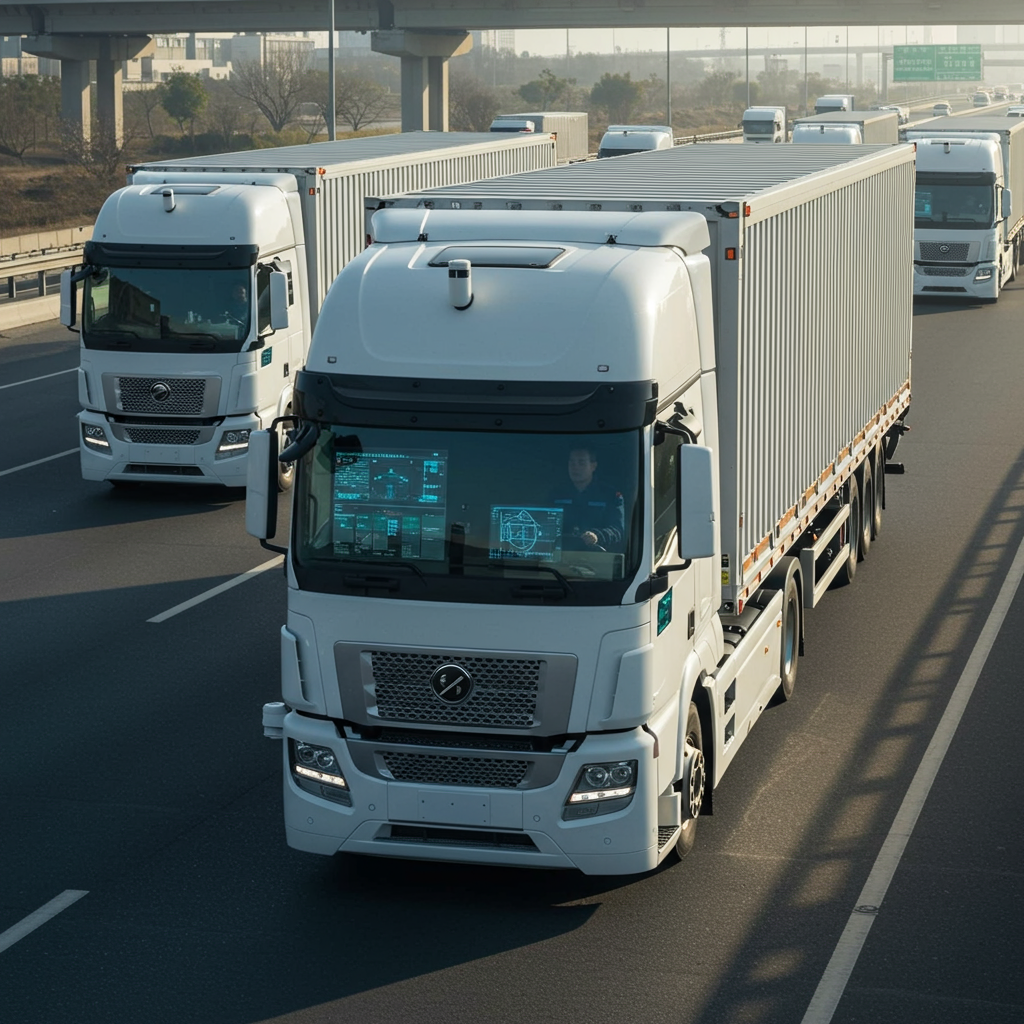Big lorries are already rumbling down the highway connecting Beijing and Tianjin port, their massive frames loaded, yet seemingly navigating themselves with an uncanny autonomy. While current government regulations mandate a human safety driver remains in the cab, the technology driving these vehicles suggests a future where they are capable of operating entirely on their own, promising a fundamental transformation of China’s vast transport and logistics industry.
For those inside, like 32-year-old safety driver Huo Kangtian, the experience is a blend of impressive innovation and initial trepidation. After starting the journey in full control, a few button presses hand the reins to the powerful machine, which capably maintains speed and navigates the public road towards Tianjin. Mr. Huo admits his first time was “a bit scared,” but extensive testing has built his confidence, leading him to view the autonomous trucks as “pretty good and safe.”
His role isn’t redundant; it’s redefined. As the “last line of defence,” he’s ready to take back control instantly in an emergency. From his perspective, autonomous mode offers significant upsides: it combats stress and fatigue on long hauls, frees up hands and feet for other tasks, and ultimately makes the job “more interesting” rather than boring. When pressed about the technology potentially eliminating his job, his response is understandably cautious.
The Driving Force: Efficiency and Cost Savings
The push for autonomous transport in China is heavily driven by economic factors. Companies like Pony AI, which operates a fleet of these driverless lorries on test routes, see this as just the beginning. Pony AI’s vice-president, Li Hengyu, highlights the potential for vastly improved transportation efficiency and substantial reductions in labour costs. Autonomous operations can also better withstand harsh environments and the demands of long driving hours that challenge human drivers.
Industry experts echo this sentiment. Technology professor Yang Ruigang from Shanghai Jiaotong University, who has extensive experience in the field across China and the US, states that the core goal is to “reduce the driver cost close to zero.” For companies, the prospect of significantly lowering operating expenses makes the investment in fully autonomous trucks easily justifiable. This shift towards driverless operations is part of a broader global trend where autonomous vehicles are expected to facilitate a transition to “mobility-as-a-service,” fundamentally altering traditional business models in transport and logistics.
Significant Hurdles Remain
Despite the clear economic incentives and technological progress, the road to widespread autonomous lorry deployment is paved with significant challenges.
Public Trust and Safety: A major hurdle is public acceptance. China has faced setbacks, including a fatal accident involving a vehicle in “auto pilot” mode that resulted in three student deaths. Economist Intelligence Unit analyst Chim Lee stresses that winning public trust is absolutely critical for policymakers and the market, particularly for trucks, given the public reaction to recent incidents involving autonomous passenger cars. Professor Yang notes that human tolerance for mistakes made by machines is much lower than for human error, demanding “extremely reliable” autonomous systems.
Regulatory Complexity: Current regulations, requiring safety drivers, are just the beginning. Globally, legal frameworks need significant updates to handle autonomous vehicles, including redefining what constitutes a “driver” and establishing clear lines of liability in case of incidents. While China is refining its regulations through local experimentation, establishing clear, nationwide rules and standards is crucial for widespread adoption.
Technical Challenges: For heavy lorries operating on open roads, technical hurdles persist. This includes improving camera and sensor capabilities to detect hazards far in advance, handling complex road layouts that might require supplementary infrastructure sensors, and ensuring reliable performance in extreme weather conditions or unexpected, chaotic traffic situations. The technology for heavy trucks is also still relatively expensive, often involving modifications to existing vehicles rather than purpose-built autonomous designs.
Beyond Long Haul: Success in Urban Delivery
While autonomous heavy trucks are still years away from routine, unrestricted use on highways, driverless technology is already making inroads in other areas, particularly in lower-speed, controlled environments like urban delivery.
The city of Hefei in Eastern China serves as a prominent example. Once a poorer city, Hefei has embraced new technology, becoming a testing ground for hundreds of driverless delivery vans operating on its suburban streets alongside conventional traffic. Companies like Rino.ai have identified a crucial market niche: using autonomous vans for the repetitive, longer-distance trips from large distribution hubs to local neighbourhood delivery stations. Human couriers then take over using scooters for the final ‘last-mile’ delivery within communities.
This model boosts overall system efficiency by allowing human couriers to focus on the final, localized leg of the journey. The economic benefits are compelling: Rino’s regional director, Zhang Qichen, notes that companies can hire three autonomous electric delivery vans, capable of running for days without charging, for the same cost as one human driver. The success in Hefei is attributed to supportive government policy, local testing, regulatory refinement, and gradual implementation. Rino reports operating over 500 vans across more than 50 Chinese cities and is even expanding internationally, with plans for a supermarket chain in Australia to begin using their driverless delivery vehicles soon.
The Future Timeline
Industry insiders and experts offer varied but optimistic timelines. While heavy trucks running unrestricted on highways are seen as at least five years away, autonomous heavy lorries operating routinely in certain specific circumstances – such as enclosed industrial zones like mines or ports, or on remote, largely straight stretches of road – could potentially become common within that five-year window. Professor Yang is confident that widespread adoption will* happen, even if the exact timeline for open highways remains a few years further off.
China is committed to championing new technologies, but this ambition must be balanced with caution regarding safety and public acceptance. The ultimate success hinges on demonstrating the tangible benefits of autonomous transport – reduced costs for consumers, increased efficiency, and a vision of societal progress – rather than being perceived primarily as a source of accidents or job losses. Building and maintaining trust requires the technology itself to be exceptionally reliable, minimizing errors in a way humans are not held to the same standard. The journey to a truly driverless transport future in China is underway, driven by economic potential, navigated through technological challenges, and ultimately dependent on public and regulatory trust.
References
- https://www.bbc.com/news/articles/c5ykel5dr62o
- https://www.bbc.co.uk/news/articles/c5ykel5dr62o
- https://au.news.yahoo.com/warning-ahead-of-major-change-coming-to-australian-roads-big-problem-212933412.html
- https://www.mckinsey.com/industries/automotive-and-assembly/our-insights/how-china-will-help-fuel-the-revolution-in-autonomous-vehicles
- https://www.mckinsey.com/industries/automotive-and-assembly/our-insights/autonomous-drivings-future-convenient-and-connected



